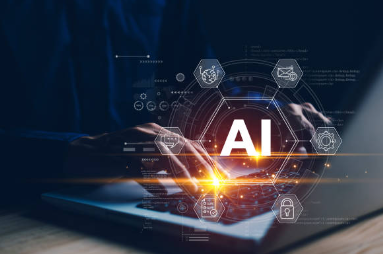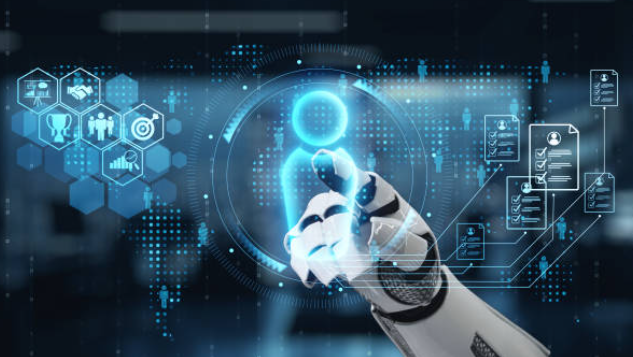AI in recruitment refers to the use of technologies like machine learning, natural language processing (NLP), and generative AI to streamline and automate tasks across the hiring funnel.
Platforms like Taggd.ai enhance these processes with enriched candidate profiles and data-driven insights, making hiring faster, fairer, and more strategic.
Today, other AI recruiting tools are optimizing job descriptions, sourcing passive candidates, engaging talent via chatbots, conducting AI-powered interviews, and even forecasting candidate retention.
As a result, hiring is becoming faster, fairer, and more data-driven than ever before.
But as AI revolutionizes recruitment, it also raises critical questions. Can machines truly make unbiased decisions? What happens when an algorithm trained on past data amplifies historical discrimination? And how do you ensure transparency when AI becomes the gatekeeper to job opportunities?
For CHROs and HR leaders, the real challenge lies not just in adopting AI, but in adopting it responsibly. That means choosing explainable tools, conducting bias audits, maintaining human oversight, and setting measurable fairness KPIs. Responsible use of AI isn’t just ethical, it’s essential to build trust with candidates and comply with tightening global hiring regulations.
So how should your organization move forward? Should you build custom AI tools tailored to your hiring needs? Buy from trusted vendors for quick implementation? Or blend the two for strategic agility?
This blog explores it all- how AI is transforming recruitment, the tangible results it delivers, the pitfalls to avoid, and a practical framework to help you implement, scale, and govern AI in hiring the right way.
Whether you’re just starting or looking to future-proof your recruitment strategy, this guide will equip you to hire smarter, faster, and fairer, with AI as your ally.
The Rise of AI in Recruitment
According to a Gartner study, over 75% of HR departments will use some form of AI in talent acquisition by the end of 2025. And truly, Artificial Intelligence in recruitment has gone from a basic screening tool to an intelligent decision-making partner for modern hiring teams.
It is highly being used in resume parsing conducting AI-powered interviews. AI in recruiting has transformed every step of the recruitment funnel. Here’s a breakdown of where it’s being used today:
- Job Description Optimization: Tools like Textio use AI to eliminate bias and improve job post-performance.
- AI-Powered Job Matching and Workflow Automation: Platforms like Taggd.ai, are streamlining recruitment workflows by combining smart engagement, intelligent matching, and process automation.
- Resume Screening and Parsing: Solutions like HireVue and SeekOut scan thousands of resumes, matching them to job descriptions in seconds.
- Candidate Sourcing: AI platforms crawl job boards and social networks to recommend passive candidates based on fit.
- Chatbots for Engagement: AI chatbots such as Paradox’s Olivia handle initial candidate queries, schedule interviews, and even conduct assessments 24/7.
- Video Interviewing with Sentiment Analysis: GenAI tools now assess not only what candidates say, but how they say it, analyzing tone, facial cues, and behavioral patterns.
- Predictive Analytics: AI forecasts candidate success, attrition risks, and even cultural fit using historical hiring data.
- Offer Optimization & Onboarding: AI personalizes offer letters and automates pre-joining workflows, creating a seamless onboarding experience.

But this transformation didn’t happen overnight. Let’s take a quick look at how AI in recruitment evolved and why it’s now reshaping hiring strategies across industries.
| Year | Milestone |
| 2000s | Rule-based resume screening tools emerge (e.g., basic ATS systems). |
| 2010–2015 | Introduction of NLP in parsing resumes and job descriptions. |
| 2016–2018 | AI sourcing tools and chatbots become mainstream (e.g., Hiretual, Mya). |
| 2019–2022 | Predictive analytics and sentiment analysis enter recruitment tech stacks. |
| 2023–2025 | GenAI revolutionizes interviewing, JD writing, and real-time candidate interaction. |
Today, we are entering the GenAI phase, where conversational AI like ChatGPT is used to simulate recruiter-candidate interactions and even co-create interview questions or assessments, cutting recruiter workload dramatically.
If you’re still wondering whether AI is worth the investment, consider these statistics:
- Up to 40% reduction in time-to-hire: AI speeds up sourcing, screening, and shortlisting.
- Up to 20% cost savings: AI reduces dependency on manual hours, leading to reduction in cost-per-hire.
- Increased candidate engagement: AI chatbots provide 24/7 support, leading to 40% faster response rates.
- Improved Quality of Hire: Predictive algorithms surface candidates who are 35% more likely to be retained beyond 18 months.
How AI Transforms the Recruitment Process
Artificial Intelligence is shaping the recruitment industry. It is being used in complete recruitment processes, starting by automating tasks, enhancing candidate sourcing, and improving the efficiency of resume screening and candidate assessment.
It’s transforming how companies attract, evaluate, and engage talent, creating faster, fairer, and more personalized hiring journeys.
From AI in hiring decisions to AI for recruiting smarter candidate pools, the technology is now embedded into nearly every step of talent acquisition. What makes this shift so powerful is that AI doesn’t replace human recruiters, it empowers them. It eliminates inefficiencies, uncovers hidden talent, and provides recruiters with data-driven insights that help them hire better, not just faster.
For job seekers, AI in recruiting means less waiting, clearer communication, and more relevant job matches. For employers, it brings a level of precision and scalability that manual processes simply can’t achieve.
AI has replaced weeks of guesswork with days of data-backed decisions.
In a talent market where speed, experience, and objectivity matter more than ever, integrating AI in talent acquisition is a strategic upgrade.

This section explores the details of AI in recruitment process. Let’s analyse what’s working and what’s not.
Candidate Sourcing & Screening
One of the most impactful applications of AI in recruiting is in candidate sourcing and screening. AI-powered tools can now parse thousands of resumes, rank candidates by relevance, and proactively source talent from platforms like LinkedIn, GitHub, and even niche forums. These AI recruiter bots use advanced machine learning to surface high-quality matches instantly, often before a human recruiter even begins a search.
Pros:
- AI recruiting tools reduce unconscious bias by anonymizing data like name, gender, or location.
- These tools pre-screen candidates based on skills, experience, and intent, saving hours of manual efforts.
- Enhances diversity by anonymizing candidate data during initial screening.
- Saves recruiter time and ensures no qualified profile is overlooked.
- Enables proactive sourcing of passive candidates with high potential.
AI-Assisted Interviews and Assessments
AI-assisted interviews are redefining how companies conduct early screening rounds. Video platforms powered by artificial intelligence in recruitment now assess candidates on tone, language, facial expressions, and even micro-expressions, often scoring them automatically before a recruiter intervenes.
Pros:
- Accelerates hiring with automated scheduling and real-time analysis.
- Increases engagement through gamification and interactive assessments.
- Enables standardized and objective evaluation across all applicants.
- Frees up recruiters to focus on relationship-building and later-stage conversations.
Predictive Hiring and Skills-Based Matching
Another key transformation brought by AI in recruitment process is predictive hiring. AI platforms today can analyze past hiring data to forecast which candidates are more likely to succeed, perform well, or remain with the organization longer.
Pros:
- Shifts hiring from instinct-driven to data-driven decisions, reducing guesswork.
- Supports skills-first hiring by emphasizing job competencies over academic degrees or brand names.
- Prioritizes candidates who are more likely to perform well and stay longer.
For example, Taggd’s AI-powered Digital Hiring Platform helps employers identify the perfect match through a 360-degree Taggd Enriched Candidate Profile. This profile includes a proprietary Taggd Score (t. score) that consolidates vital candidate information and insights that would traditionally take weeks to validate manually.
By offering ready-to-hire candidates, Taggd dramatically shortens the hiring cycle from months to days, bringing precision and agility to large-scale recruitment.
Candidate Engagement with Chatbots
Chatbots are quickly becoming the face of AI in hiring. From managing FAQs to sending reminders and scheduling interviews, AI chatbots are handling large volumes of candidate interaction with speed and consistency.
Pros:
- Offers 24/7 communication, improving responsiveness and trust.
- Boosts application completion rates by reducing candidate drop-offs.
- Personalizes engagement at scale, especially during high-volume hiring drives.
- Streamlines coordination, ensuring candidates stay informed and engaged.
AI in recruitment is delivering measurable benefits across the board from faster sourcing and smarter screening to more engaging candidate experiences and better hiring outcomes.
The result? Higher efficiency, stronger hires, and a competitive edge in the war for talent.
Ensuring Fairness in AI-Powered Recruiting
With all the impressive benefits of AI in recruiting from speed and scale to smarter decisions, it’s easy to assume the technology is a perfect solution.
But amid the efficiency and innovation, a crucial question arises: Is AI truly fair or simply faster at amplifying old biases? After all, AI systems are only as good as the data we feed them. And in many cases, that data reflects years, sometimes decades of historical bias in hiring practices.
So, while AI in hiring can help improve efficiency, it also raises important questions around ethics, accountability, and fairness.
Take Amazon’s infamous AI recruiting tool, which was scrapped after it systematically penalized resumes that included the word “women’s”, as in “women’s chess club” or “women’s leadership society.” The model had learned from years of male-dominated hiring data and mirrored those patterns, unintentionally discriminating against female candidates.
That wasn’t just a technical failure, it was an ethical wake-up call.
And regulators are responding. In 2023, New York City enacted Local Law 144, requiring companies to conduct independent algorithmic audits before using AI-based hiring tools. The primary goal is to ensure that AI recruiting tools and systems don’t reinforce existing discrimination under the guise of efficiency.
Yet, according to SHRM, 41% of companies are still unable to explain how their hiring AI makes decisions. And fewer than 20% of those using AI in recruitment conduct regular, third-party bias audits.
So, what does this mean for talent leaders?
It means AI must be wielded with intention, transparency, and oversight. That efficiency and ethics must go hand in hand. And that the goal isn’t to walk away from AI, but to build better, fairer AI.
Ask yourself:
- Are your AI tools advancing equity or simply accelerating legacy biases?
- Do you know how your algorithms rank and reject candidates?
- Could you defend your AI’s hiring decisions in a compliance audit or court of law?
As AI hiring regulations tighten globally, the need for explainable, auditable, and ethical recruiting AI will only grow. Much like labor laws, AI governance may soon become standard practice.
This isn’t the end of AI in recruitment. It’s the beginning of a more responsible, inclusive, and transparent future.
Because the real promise of AI in talent acquisition isn’t just about speed or scale. It’s about hiring better and fairer at the same time.
Best Practices for Responsible AI in Recruitment
Artificial Intelligence can supercharge recruitment, but only when used with caution, transparency, and humanity. As algorithms begin making or influencing decisions about who gets hired (and who doesn’t), HR leaders must ensure the systems are fair, explainable, and aligned with organizational values.
To use AI in recruiting responsibly, HR leaders must conduct regular third-party bias audits, choose explainable AI vendors, maintain human oversight in decisions, track fairness KPIs, and train models on diverse, inclusive datasets to ensure ethical, unbiased outcomes.

Here’s a detailed explanation of how to do it right:
Conduct Third-Party Bias Audits Regularly
Even the smartest algorithms can reflect the unconscious biases embedded in historical data. That’s why regular external audits are essential.
It is necessary to bring in independent experts or certified vendors to review the AI tools for any signs of bias, whether by gender, ethnicity, age, or other protected characteristics.
A tool trained on past hiring data may unknowingly favor candidates who “look like” previous hires, excluding others unfairly. Audits help spot these issues early and ensure your systems stay fair and compliant.
Pro tip: Schedule audits annually or whenever you significantly change your hiring criteria or data sources.
Partner with Vendors Who Offer Explainability
Not all AI is a black box. The best vendors build explainable AI (XAI) systems that show why a particular candidate was shortlisted, scored, or rejected.
To overcome AI recruiting challenges and use AI in recruiting responsibly, HR leaders must look for:
- Transparent scoring criteria
- Insight into what influenced a match (skills, experience, cultural alignment)
- Ability to generate human-readable reports for compliance reviews
When a candidate challenges a hiring decision, or a regulator comes knocking, you must be able to justify and explain the outcome, not just shrug and say, “The algorithm said so.”
Use a Human-in-the-Loop (HITL) Approach
AI should assist, not replace human judgment, especially for final hiring decisions. Let AI handle repetitive tasks like resume screening, skill matching, or interview scheduling.
But ensure that human recruiters always review AI-recommended candidates before making offers or rejections.
Benefits:
- Adds empathy and context to decisions
- Allows recruiters to override the AI if necessary
- Builds trust with candidates and stakeholders
For example: If AI flags a candidate as a “low fit” due to a career gap, a human recruiter can review the profile and recognize the reason (e.g., caregiving, entrepreneurship) and still move forward.
Define and Monitor Fairness KPIs
Fair hiring isn’t just about intentions, it’s about outcomes. Set measurable fairness goals and track them consistently.
Suggested KPIs:
- DEI Impact: Are underrepresented groups advancing through each hiring stage?
- Rejection Rate Parity: Are rejection rates similar across gender, caste, and regional groups?
- Interview-to-Offer Ratios: Are some groups consistently interviewed but rarely offered roles?
If AI unintentionally favors certain demographics, your KPIs will catch it early and help you make corrections before it impacts your employer brand or legal standing.
Train AI Models on Diverse, Representative Datasets
AI learns from the past. If your training data lacks diversity, your hiring future will too.
Best practice: Ensure the data used to train your AI models includes:
- A wide range of roles, industries, and career paths
- Candidates from different regions, backgrounds, and educational levels
- Inclusive language that doesn’t penalize non-traditional resumes
An AI trained only on urban, elite, English-language resumes might struggle to evaluate rural or regional talent fairly. Diversity in data leads to equity in outcomes.
With these practices, you’ll be able to reduce AI in hiring responsibly. Besides, when you are confident that the AI recruiting tools are appropriate, you can easily prove that recruitment adds business value.
AI in Recruitment Adoption Framework for HR Leaders
Implementing AI into hiring practices isn’t about flipping a switch. For HR leaders, the smartest approach is a phased adoption strategy that balances innovation with responsibility, compliance, and candidate experience.
Here’s a practical framework to guide your journey:
Stage 1: Task Automation
At this stage, organizations begin by automating repetitive, time-consuming recruitment tasks. The focus is on efficiency and consistency.
Common Tools & Tactics:
- Resume parsing and keyword filtering
- Interview scheduling bots
- Automated screening for basic eligibility
- AI chat assistants to answer candidate FAQs
Business Impact:
- Accelerates early-stage screening
- Reduces administrative burden on HR
- Improves turnaround time and candidate responsiveness
However, don’t let automation lead to exclusion. Rule-based filters may ignore non-traditional yet capable candidates.
Stage 2: Intelligent Matching
Now the organization upgrades from filtering to contextual matching. AI helps identify candidates who align with the role’s skills, values, and growth potential.
Common Tools & Tactics:
- AI-powered job-candidate match algorithms
- Skill cloud mapping and experience ranking
- Shortlist enrichment with behavioral and cultural indicators
For example: Platforms like Taggd use enriched data to generate a T.Score, helping employers instantly recognize job-ready, high-fit candidates.
Business Impact:
- Boosts quality-of-hire
- Reduces bias in manual shortlisting
- Shortens time-to-fill across roles
However, ensure the AI isn’t making decisions in a black box. You should be able to audit, tweak, and override recommendations.
Stage 3: Predictive Hiring & Fairness Monitoring
At this stage, HR leaders adopt AI tools to make data-driven hiring decisions and proactively ensure fairness in the process.
Common Tools & Tactics:
- Attrition risk prediction
- Offer acceptance likelihood scoring
- Interview sentiment analysis
- Bias detection dashboards
Business Impact:
- Enhances long-term hiring success
- Improves DEI outcomes and compliance
- Enables ethical and transparent hiring practices
However, predictive models are only as good as the data they’re trained on. Guard against reinforcing past biases and always involve human judgment.
Stage 4: Fully Integrated, Auditable AI Hiring Systems
In the final stage, AI becomes a core part of the recruitment operating system, integrated across every step, from sourcing to onboarding — with full traceability and accountability.
Common Tools & Tactics:
- Seamless AI + ATS integration
- AI-generated hiring dashboards
- Real-time audit trails and explainability modules
- Compliance alignment with global hiring regulations
Business Impact:
- Elevates hiring to a strategic business function
- Builds stakeholder trust (leadership, DEI teams, candidates)
- Future-proofs recruitment with ethical governance
However, keep humans in the loop. Define clear boundaries: when AI recommends, and when humans decide.
AI in Recruitment Maturity Model
| Stage | Focus Area | Key AI Applications | Benefits | Risks to Manage |
| 1. Task Automation | Speed & efficiency | Resume screening, scheduling, chatbots | Time savings, reduced workload | Exclusion due to rigid filters |
| 2. Intelligent Matching | Relevance & job fit | Contextual matching, skill analysis | Higher-quality shortlists | Unseen bias in algorithms |
| 3. Predictive & Fair AI | Decision intelligence & fairness | Attrition prediction, DEI tracking | Smarter hiring, proactive bias checks | Overreliance on predictions |
| 4. Integrated & Auditable AI | Trust, compliance, scale | AI-ATS integration, audit trails | Strategic value, transparency | Compliance and explainability gaps |
So, if you’re just starting out, don’t rush into full integration. Start with pilot programs focused on one function or geography. Measure what works, refine what doesn’t.
Tips for HR Leaders
- Partner with legal and DEI teams to set up ethical AI guardrails.
- Ask vendors: Can your AI explain why it made this recommendation?
- Build a cross-functional task force for AI governance in talent acquisition.
- Educate your recruiters, not to fear AI, but to collaborate with it.
Should Your Organization Buy, Build, or Blend AI in Recruitment?
As AI reshapes the recruitment landscape, this shift comes a big question: Should you build proprietary AI tools, buy ready-made solutions, or blend both approaches to balance innovation with scalability?
There’s no one-size-fits-all answer. Each path comes with trade-offs in cost, control, speed, and data ownership. The key lies in aligning your AI strategy with your organization’s recruitment goals, tech readiness, and long-term vision.
Let’s break down the decision criteria to help you choose the right direction.
Build to gain full control with customization
Building your own AI recruitment solution gives you complete control over customization, data usage, and long-term scalability. This is ideal for large enterprises with strong internal tech teams, rich hiring data, and unique recruitment workflows that off-the-shelf tools can’t handle.
However, this route demands high upfront investment, longer deployment timelines, and ongoing maintenance. If talent is your competitive advantage and you’re in it for the long haul, this is worth exploring.
Buy to implement quick speed and simplicity
Buying pre-built AI tools is the fastest way to start your AI journey. Many vendors offer plug-and-play platforms for screening, matching, and engagement, often trained on large datasets.
This approach is cost-effective, quick to deploy, and scalable for most standard hiring needs. However, customization is limited to what the vendor offers, and you may share data with external providers. It’s ideal for companies that need immediate results without heavy IT involvement.
Blend for strategic agility
A blended model combines the best of both worlds. For example, you might buy an AI screening engine, but build custom analytics dashboards on top of it. Or you could use vendor models trained on public data but layer your proprietary talent insights for a personalized experience.
This approach allows flexibility, moderate cost, and faster go-to-market, especially for organizations evolving their talent tech stack gradually.
Here’s how to navigate that choice based on key decision criteria:
| Criteria | Build | Buy | Blend |
| Cost | High upfront | Medium | Flexible |
| Customization | Full control | Vendor-limited | Use-case based |
| Time to Deploy | Long | Fast | Medium |
| Data Privacy | Full ownership | Shared | Shared |
| Talent Intelligence | Internalized | Pre-trained | Augmented |
Start by mapping your recruitment pain points to technology gaps. Then assess your internal capabilities before deciding whether to build, buy, or blend. Remember, the goal isn’t just automation, it’s strategic transformation.
The Future of AI in Recruiting
As we look ahead, AI’s role in recruitment is poised to move far beyond automation. The next frontier will be marked by personalization, intelligence augmentation, and ethical innovation.
But with great power comes great responsibility and for CHROs and HR leaders, this future demands not just enthusiasm, but stewardship.

AI Will Power Internal Talent Ecosystems
Tomorrow’s AI hiring systems won’t just source external talent—they’ll help you unlock internal mobility, identify hidden potential, and chart personalized upskilling paths for your current workforce. Imagine a system that nudges employees toward lateral or upward moves based on skill adjacencies, performance history, and career goals.
Personalized Job Ads and JDs
AI for recruiting will soon create real-time personalized job descriptions and job ads tailored to specific personas. Whether you’re targeting passive candidates on LinkedIn or re-engaging silver medalists in your ATS, LLMs (large language models) can fine-tune messaging, tone, and content for maximum impact.
LLMs as Talent Experience Architects
Advanced LLMs are already being tested for interview coaching, language translation, real-time onboarding assistance, and even culture-fit simulations. This means recruiters won’t just be hiring experts—they’ll be orchestrating experiences powered by AI, enhancing both candidate and hiring manager satisfaction.
But there’s a catch…
The Ethical Edge: A Double-Edged Sword
AI in recruitment is powerful but imperfect. Hallucinations, biased training data, and opaque algorithms can lead to false positives, unfair exclusions, and loss of human trust.
For instance, a seemingly neutral resume parser might filter out candidates from underrepresented groups due to historical bias in training data. If not critically reviewed, such tools can hard-code discrimination into your hiring pipeline.
That’s why governance and intent matter more than the algorithm itself.
Wrapping Up
AI in recruitment is not merely a technological shift, it’s a philosophical one. It challenges how we define fairness, how we treat people, and how we make decisions that change lives.
When used thoughtfully, AI for recruiting can democratize opportunity, reduce hiring friction, and help build diverse, high-performing teams. But when left unchecked, it can reinforce the very inequities we’ve worked hard to eliminate.
So, here’s a final thought for CHROs and HR leaders:
Audit your recruitment tech stack. Ask not just what AI can automate but what it should elevate. And if in doubt, let the humans lead.
Because at the end of the day, technology should serve people, not the other way around.
Explore how Taggd, one of India’s top Recruitment Process Outsourcing (RPO) companies, can help you harness AI to hire smarter, faster, and fairer with enriched candidate profiles, ready-to-hire talent pools, and data-driven recruitment strategies.

![Jobs in Chennai [2026] Top Roles, Industries & Hiring Trends](https://taggd.in/wp-content/uploads/2026/01/Jobs-in-Chennai-2026-Top-Roles-Industries-Hiring-Trends-768x513.jpg)
![Jobs in Pune [2026] Top Roles, Industries, Salaries & Hiring Trends](https://taggd.in/wp-content/uploads/2026/01/Jobs-in-Pune-2026-Top-Roles-Industries-Salaries-Hiring-Trends-768x512.jpg)


![Customer Support Jobs in India [2026] Roles, Remote Opportunities, Skills & Hiring Trends](https://taggd.in/wp-content/uploads/2025/12/Customer-Support-Jobs-in-India-2026-Roles-Remote-Opportunities-Skills-Hiring-Trends-768x512.jpg)
